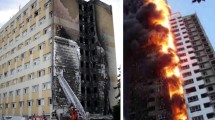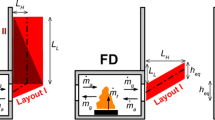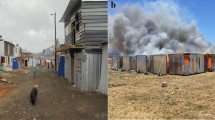Abstract
In a compartment fire, externally venting flames (EVF) may significantly increase the risk of fire spreading to adjacent floors or buildings; EVF-induced risks are constantly growing due to the ever-increasing trend of using combustible materials in building facades. The main aim of this work is to investigate the fundamental physical phenomena associated with EVF and the factors influencing their dynamic development. In this context, a series of fire tests is conducted in a medium-scale compartment-façade configuration; an n-hexane liquid pool fire is employed, aiming to realistically simulate an “expendable” fire source. A parametric study is performed by varying the fire load density (127.75, 255.5 and 511 MJ/m2) and ventilation factor (0.071 and 0.033 m3/2). Emphasis is given to characterization of the thermal field developing adjacent to the façade wall. Experimental results suggest that the three characteristic EVF phases, namely “internal flaming”, “intermittent flame ejection” and “consistent external flaming”, are mainly affected by the opening dimensions, whereas the fuel load has a notable impact on the fuel consumption rate and heat flux to the façade. Fuel consumption rates were found to increase with increasing fire load and opening area, whereas the global equivalence ratio increases with decreasing opening factor. The obtained extensive set of experimental data can be used to validate CFD fire models as well as to evaluate the accuracy of available fire design correlations.
















Similar content being viewed by others
Abbreviations
- A v H 1/2 v :
-
Ventilation factor (m3/2)
- C d :
-
Opening discharge coefficient (0.68)
- H v :
-
Opening height (m)
- m f :
-
Fuel mass (kg)
- \( {\dot{{m}}}_{{air}} \) :
-
Air supply rate into the fire compartment (kg/s)
- \( {\dot{{m}}}_{{fuel}} \) :
-
Fuel mass loss rate (kg/s)
- Q″:
-
Fire load density (MJ/m2)
- \( {\dot{{Q}}}_{{tot}} \) :
-
Average heat release rate (kW)
- \( {\dot{{Q}}}_{{ex}} \) :
-
Excess heat release rate (kW)
- \( {\dot{{Q}}}_{{in,max}} \) :
-
Heat release rate at the interior of the compartment (kW)
- RH ∞ :
-
Relative humidity of ambient air (%)
- r :
-
Fuel to air stoichiometric ratio
- T g :
-
Upper gas layer temperature (°C)
- T ∞ :
-
Ambient air temperature (°C)
- t dur :
-
Total fire duration (s)
- V f :
-
Fuel volume (lt)
- w v :
-
Opening width (m)
- ρ 0 :
-
Ambient air density (kg/m3)
- ρ :
-
Density of the hot combustion products (kg/m3)
- CEF:
-
Consistent external flaming
- CB:
-
Compartment back
- CF:
-
Compartment front
- EVF:
-
Externally venting flames
- GER:
-
Global equivalence ratio
- IF:
-
Internal flaming
- IFE:
-
Intermittent flame ejection
References
Nishio Y, Yoshioka H, Noguchi T, Kanematsu M, Ando T, Hase Y, Hayakawa (2015) Fire spread caused by combustible facades in Japan. Fire Technol 53:1–26. doi:10.1007/s10694-015-0535-5
White N, Delichatsios M (2014) Fire hazards of exterior wall assemblies containing combustible components. Springer Briefs in Fire, Springer, New York
Yokoi S (1960) Study on the prevention of fire spread caused by hot upward current. Building Research Institute, Report No 34, Tokyo, Japan
Thomas IR, Moinuddin KA, Bennetts ID (2007) The effect of quantity and location on small enclosure fires. J Fire Prot Eng 17:85–102.
Oleszkiewicz I (1989) Heat transfer from a window fire plume to a building façade. Reprinted from “Collected papers in heat transfer”, HTD-Vol. 123. Marner WJ, Chen TC, Faghri M, Peterson GP, Kuehn TH, Pate MB, Mahajan RL and Lavine AS (eds) Book No. H00526.
Tang F, Hu LH, Delichatsios MA, Lu KH, Zhu W (2012) Experimental study on flame height and temperature profile of buoyant window spill plume from an under-ventilated compartment fire. Int J Heat Mass Tran 55:93–101.
Oleszkiewicz I (1991) Vertical separation of windows using spandrel walls and horizontal projections. Fire Technol 4:334–340.
Eurocode 1 (EN 1991-1-2) (2002) Actions on structures, Part 1–2—General actions: actions on structures exposed to fire, Brussels
Quintiere JG (2006) Fundamentals of Fire Phenomena. Wiley, West Sussex
Hu L, Qiu Z, Lu K, Tang F (2015) Window ejected flame width and depth evolution along façade from under-ventilated enclosure fires. Fire Saf J 76:44–53.
Himoto K, Tsuchihashi T, Tanaka Y, Tanaka T (2009) Modelling the trajectory of window flames with regard to flow attachment to the adjacent wall. Fire Saf J 44: 250–258.
Delichatsios M, Lee Y, Tofilo P (2009) A new correlation for gas temperature inside a burning enclosure. Fire Saf J 44:1003–1009.
Hurley MJ (2016) SFPE Handbook of fire protection engineering. 5th Ed., SFPE, Quincy, Massachusetts
Klopovic S, Turan OF (2001) A comprehensive study of externally venting flames, Part I: Experimental plume characteristics for through-draft and no through-draft ventilation conditions and repeatability. Fire Saf J 36:99–133.
Klopovic S, Turan OF (2001) A comprehensive study of externally venting flames, Part II: Plume envelope and centre-line temperature comparisons, secondary fires, wind effects and smoke management system. Fire Saf J 36:135–172.
Empis A (2010) Analysis of the compartment fire parameters influencing the heat flux incident on the structural façade. Ph.D. Thesis, University of Edinburgh, U.K.
Kawagoe K (1958) Fire Behaviour in Rooms. Report of the Building Research Institute of Japan, No 27
Babrauskas V (1976) Fire Endurance in a Building, Report No. UBC FRG-76-16. Berkley, USA
Parkes AR (2009) The impact of size and location of pool fires on compartment fire behaviour. Ph.D. Thesis, University of Canterbury, New Zealand
Hwang C, Lock A, Bundy M, Johnsoon E and Ko GH (2011) Effects of fuel location and distribution on full-scale underventilated compartment fires, J Fire Sci 29: 21–52.
Drysdale D (1998) An introduction to fire dynamics, 2th Ed., John Wiley & Sons, New York, USA
Chamichine AV, Makhviladze GM, Oleszcak P and Yakush SE (2007) Flame exhaust from pool fires in a small scale compartment with a single opening. In: Proceedings of the 5th International Seminar on Fire and Explosion Hazards, Edinburgh, UK, 23–27 April 2007
Hu L, Lu K, Delichatsios M, He L, Tang F (2012) An experimental investigation and statistical characterization of intermittent flame ejecting behaviour of enclosure fires with an opening. Combust Flame 159:1178–1184.
ISO 9705 (1993) International Organization for Standardization, ISO 9705 Fire Tests: Full-Scale Room Test for Surface Products, Geneva
Gottuk DT, Roby RJ, Peatross MJ and Beyler CL (1992) Carbon monoxide production in compartment fires. J Fire Prot Eng 4: 133–150.
Audouin L, Such JM, Malet JC and Casselmam C (1997) A real scenario for a Ghosting Flame. In: Proceedings of the Fifth International Symposium on Fire Safety Science, 1997, pp. 1261–1272.
ASTM D240-14 (2014) Standard test method for heat of combustion of liquid hydrocarbon fuels by bomb calorimeter. ASTM International, West Conshohocken
Kolaitis DI, Asimakopoulou EK, Founti MA (2014) Fire protection of light and massive timber elements using gypsum plasterboards and wood based panels: A large-scale compartment fire test. Constr Build Mater 73:163–170.
Bentley R (1998) Handbook of temperature measurement. Springer, Singapore
Jones JC (2014) Thermocouple usage in an irradiance experiment, J Fire Sci 32: 563–567.
Utiskul Y (2006) Theoretical and experimental study on fully-developed compartment fires. NIST GCR 07-907, National Institute of Standards and Technology, USA
Hamins A, Maranghides A, McGrattan K, Johnsosson E, Ohlemiller T, Donnelly M, Yang J, Mulholland G, Prasad K, Kukuck S, Anleitner R, McAllister T (2005) Federal building and fire investigation of the World Trade Center disaster: Experiments and modelling of structural elements exposed to fire, NIST NCSTAR 1-5B, National Institute of Standards and Technology, USA
ASTM E603-13 (2013), Standard guide for room fire experiments. ASTM International, West Conshohocken
Kolaitis DI, Founti MA (2013) Development of a solid reaction kinetics gypsum dehydration model appropriate for CFD simulation of gypsum plasterboard wall assemblies exposed to fire. Fire Saf J 58:151–159.
Asimakopoulou EK, Kolaitis DI, Founti MA (2015) Evaluation of fire engineering design correlations for externally venting flames using a medium-scale compartment façade fire experiment. In: Proceedings of the 9th Mediterranean Combustion Symposium, Rhodes, Greece, 7–11 June 2015.
Gottuk DT, Roby RJ, Beyler CL (1992) A study of CO and smoke yields from compartment fires with external burning. In: 24th Symposium (International) on Combustion, The Combustion Institute, pp. 1729–1735.
Nasr A, Suard S, El-Rabii H, Gay L, Garo JP (2011) Fuel mass-loss rate determination in a confined and mechanically ventilated compartment fire using a global approach. Combust Sci Technol 183: 1342–1359.
Makhviladze GM, Shamshin AV, Yakush SE, Zykov AP (2006) Experimental and numerical study of transient compartment fires. Combust Explo Shock 42:723–730.
Law M (1978) Fire safety of external building elements—the design approach. AISC Eng J, 2nd Quarter, pp. 59–74.
Seigel LG (1969) The projection of flames from burning buildings. Fire Technol 5: 43–51.
Thomas PH, Heselden AJM (1972) Fully developed fires in single compartments: a cooperative research programme of the Conseil Internationale du Batiment, Conseil Internationale du Batiment Report No 20, Fire Research Note No 923.
Thomas PH (1991) Fire, flames and dimensional analysis. In: Proceedings of the 3rd International Symposium on Fire Safety Science, International Association for Fire Safety Science, pp. 3–26.
Beyler CL (1986) Fire plumes and ceiling jets. Fire Saf J 11:53–75.
Pitts WM (1997) An algorithm for estimation carbon monoxide formation in enclosure fires. In: Proceedings of the 5th International Symposium on Fire Safety Science, International Association for Fire Safety Science, pp. 535–546.
Forell B, Hosser D (2007) The relationship between ventilation conditions and carbon monoxide source term in fully-developed compartment fires. In: Drysdale D et al. (ed) Proceedings of the 5th International Seminar on Fire and Explosion Hazards, Edinburgh, UK, 23–27 April 2007, pp. 825–835.
Saito K (1993) Study of fire induced flow along the vertical cornel wall. Part 2, final report. NIST GCR 93-628.
Zhao G, Beji T, Merci B (2015) Application of FDS to under-ventilated enclosure fires with external flaming. Fire Technol. doi:10.1007/s10694-015-0552-4.
Nakos JT (2004) Uncertainty analysis of thermocouple measurements used in normal and abnormal thermal environment experiments at Sandia’s radiant heat facility and Lurance Canyon burn site. Technical Report SAND2004-1023, Sandia National Laboratories, Albuquerque, USA
Lock A, Bundy M, Johnsson EL, Hamins A, Ko GH, Hwang C, Fuss P, Harris R (2008) Experimental study of the effect of fuel type, fuel distribution and vent size on full-scale underventilated compartment fires in an ISO 9705 room, NIST Technical Note 1603.
Ukleja S (2012) Production of smoke and carbon monoxide in under-ventilated enclosure fires, Ph.D. Thesis, Ulster University, UK
Acknowledgments
This study has been financially supported by the “Fire-Facts” project in the frame of the ARISTEIA action (operational program “Education and Lifelong Learning”) that is co-financed by Greece and the E.U. and by the E.C. in the frame of two FP7 projects, “MeeFS: Multifunctional Energy Efficient Façade System for Building Retrofitting” (EeB.NMP.2011-3, Grant No. 285411) and “ELISSA: Energy Efficient Lightweight-Sustainable-Safe-Steel Construction” (EeB.NMP.2013-1, Grant No. 609086).
Author information
Authors and Affiliations
Corresponding author
Appendix: Estimation of Experimental Errors
Appendix: Estimation of Experimental Errors
The ASME methodology [48] has been used to estimate the uncertainty of the measurements presented in this work. The total (expanded) measurement uncertainty (U t ) is estimated using Eq. (A.1), where B t is the root sum square of the elemental uncertainty estimated by statistical methods (e.g., systematic or bias uncertainties) and S t is the root sum square of the elemental uncertainty estimated using non-statistical methods (e.g., scientific judgment, manufacturer’s specifications, calibration reports, random uncertainties). The expanded uncertainty is obtained by multiplying the combined standard uncertainty by a coverage factor k; in this work, a coverage factor value of k = 2 was used, aiming to achieve a 95% confidence interval (2σ) for the total uncertainty [49]. The values of the root sum square (B t or S t ) of the various types of elemental uncertainties (B i or S i ) are calculated using Eq. (A.2).
Gas and wall surface temperatures were measured using K-type thermocouples connected to the signal acquisition system via extension wires. Bare-bead thermocouples are assumed to have negligible statistical uncertainties (B t = 0) [49]. In terms of the S t uncertainties, the K-type thermocouples used in the tests exhibited a standard calibration uncertainty ±2.2°C or ± 0.75% of the measurement reading (the largest value is taken into account) for a 99% confidence interval (3σ); in this work, the respective values of ±1.5°C or ±0.5% have been used to achieve a 95% confidence interval (2σ). Another source of error in bare bead thermocouple measurements is radiative losses. Attempts of estimating the error due to radiation can be found in the literature [50]; in the current study radiative loss errors were assumed to be 0% to −6%. In addition, a ±3% random error was introduced in the analysis.
Measurements using heat flux sensors are subjected to errors due to sensor properties, calibration traceability, quality assurance and measurement-related uncertainties. The initial calibration accuracy of the heat flux sensors used in the tests was ±3%. In addition to this error, the most significant error sources are non-linearity, convection and the radiative heat transfer balance. A ±1% sensitivity error was employed, based on the assumption that the mean air speed was 0.5 m/s; also, a ±6% convective error and a ±3% random error were also taken into account.
In terms of the gas concentration measurements, the real-time gas analyser used in the tests exhibited an equipment uncertainty of ±1%. The calibration gases used for zero and span calibrations exhibited negligible uncertainties, as reported by the manufacturers. Zero and span calibrations performed prior to each experiment showed a systematic standard uncertainty of ±1%. Random and mixing/averaging errors due to the sampling lines, equal to ±3% and ±5%, respectively, were the larger sources of uncertainty. Estimated values for all components of measurement uncertainty are tabulated in Table A1. Indicative values of the estimated experimental errors for the gas temperature inside and outside the fire compartment and the heat flux to the façade surface are presented in Figures 6 and 14.
Rights and permissions
About this article
Cite this article
Asimakopoulou, E.K., Chotzoglou, K., Kolaitis, D.I. et al. Characteristics of Externally Venting Flames and Their Effect on the Façade: A Detailed Experimental Study. Fire Technol 52, 2043–2069 (2016). https://doi.org/10.1007/s10694-016-0575-5
Received:
Accepted:
Published:
Issue Date:
DOI: https://doi.org/10.1007/s10694-016-0575-5




